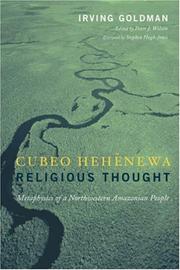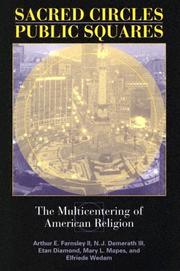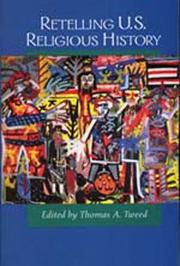| Listing 1 - 10 of 47 | << page >> |
Sort by
|

ISBN: 1281897515 9786613792525 023150361X 9780231503617 9780231130202 0231130201 9780231130219 023113021X 9781281897510 Year: 2004 Publisher: New York Columbia University Press
Abstract | Keywords | Export | Availability | Bookmark
 Loading...
Loading...Choose an application
- Reference Manager
- EndNote
- RefWorks (Direct export to RefWorks)
The societies of the Vaupés region are now among the most documented indigenous cultures of the New World, in part because they are thought to resemble earlier civilizations lost during initial colonial conflict. Here at last is the eagerly awaited publication of a posthumous work by the man widely regarded as the preeminent authority on Vaupés Amazonian societies. Cubeo Hehénewa Religious Thought will be the definitive account of the religious worldview of a significant Amazonian culture. Cubeo religious thought incorporates ideas about the nature of the cosmos, society, and human life; the individual's orientation to the world; the use of hallucinogenic substances; and a New World metaphysics. This volume was substantially completed before Irving Goldman's death, but Peter Wilson has edited it for publication, providing a thorough introduction to Goldman's work. Stephen Hugh-Jones has contributed an afterword, setting the work in the context of contemporary Vaupés ethnography.
Religion --- Philosophy & Religion --- North & South American Religions
Book
ISBN: 2707165972 Year: 2009 Publisher: Paris (9bis, rue Abel Hovelacque 75013) : La Découverte,
Abstract | Keywords | Export | Availability | Bookmark
 Loading...
Loading...Choose an application
- Reference Manager
- EndNote
- RefWorks (Direct export to RefWorks)
Les États-Unis présenteraient le cas unique, dans le monde occidental, d'une démocratie ayant réservé à la religion une place à part dans la vie politique : voici une affirmation qui fait aujourd'hui figure de lieu commun. En ne retenant que les manifestations d'une certaine religiosité publique, on oublie de rappeler que la République américaine est fermement laïque, le Premier amendement garantissant la séparation des Églises et de l'État. Surtout, on passe à côté de la spécificité de ce pays qui explique le sentiment d'étrangeté qu'il nous inspire. Deux forces contradictoires y coexistent : un esprit de religion que l'on peut ramener à la volonté de placer l'ordre civil sous tutelle chrétienne, et un esprit de laïcité qui tend à l'inverse à cantonner la religion dans la sphère privée. Au cours de l'histoire, ces deux forces ont alterné par vagues successives, sans que jamais l'édifice laïque ne soit véritablement menacé. La synthèse a longtemps été assurée par la notion de « religion civile » qui associe idéal libéral et parrainage divin de la nation en une sorte de credo civil commun.
Religion --- Philosophy & Religion --- North & South American Religions
Book
ISBN: 2130598145 Year: 2001 Publisher: Paris (6, avenue Reille 75685) : P.U.F.,
Abstract | Keywords | Export | Availability | Bookmark
 Loading...
Loading...Choose an application
- Reference Manager
- EndNote
- RefWorks (Direct export to RefWorks)
Religion --- Philosophy & Religion --- North & South American Religions --- United States --- Religion.
Book
Year: 2009 Publisher: Brazil : EDUFBA,
Abstract | Keywords | Export | Availability | Bookmark
 Loading...
Loading...Choose an application
- Reference Manager
- EndNote
- RefWorks (Direct export to RefWorks)
In the current times of increasing public visibility for candomblés, their records in the tombo books and the rhetoric for the preservation of Afro-Brazilian cultural heritage, it is not superfluous to take a close look at a not so remote past in which such African-based practices were sometimes silenced, sometimes persecuted and depreciated because they are identified with delay and deviation from European civilizing models. If this retrospective look proves salutary in realizing how much progress has been made, it also alerts us to how much more needs to be done, since the discourses of religious intolerance of yesterday are spreading today, although in new pulpits, with the same harmful effects. In this sense, Edmar Ferreira Santos' book achieves a goal that any research in social history can aim for: that of allowing us to understand in detail the complexity of the past, through it, to illuminate the paradoxes of the present (excerpt taken from the preface of the book).
North & South American Religions --- Religion --- Philosophy & Religion --- Bahia (Brazil : State) --- Religious life and customs.
Book
Year: 2009 Publisher: Brazil : EDUFBA,
Abstract | Keywords | Export | Availability | Bookmark
 Loading...
Loading...Choose an application
- Reference Manager
- EndNote
- RefWorks (Direct export to RefWorks)
In the current times of increasing public visibility for candomblés, their records in the tombo books and the rhetoric for the preservation of Afro-Brazilian cultural heritage, it is not superfluous to take a close look at a not so remote past in which such African-based practices were sometimes silenced, sometimes persecuted and depreciated because they are identified with delay and deviation from European civilizing models. If this retrospective look proves salutary in realizing how much progress has been made, it also alerts us to how much more needs to be done, since the discourses of religious intolerance of yesterday are spreading today, although in new pulpits, with the same harmful effects. In this sense, Edmar Ferreira Santos' book achieves a goal that any research in social history can aim for: that of allowing us to understand in detail the complexity of the past, through it, to illuminate the paradoxes of the present (excerpt taken from the preface of the book).
North & South American Religions --- Religion --- Philosophy & Religion --- Bahia (Brazil : State) --- Religious life and customs.
Book
ISBN: 9783031561603 Year: 2024 Publisher: Cham : Springer Nature Switzerland : Imprint: Palgrave Macmillan,
Abstract | Keywords | Export | Availability | Bookmark
 Loading...
Loading...Choose an application
- Reference Manager
- EndNote
- RefWorks (Direct export to RefWorks)
"Apocalypse is as American as apple pie, and if you've ever wondered why - from prepping to pandemics - you have come to the right book. Since the atomic blasts at Los Alamos, America has always had a special twist, a special take, on the end of the world, and Gittinger's audit of America's apocalyptic practice in this moment is more than just great fun and games, it's a revelation all its own. These apocalyptic anxieties teach us about ourselves, who we are, who we hope to be, and what we think is real and meaningful. Here is cultural philosophy as entertaining as it is enlightening." --Robert J. Joustra, Professor Politics & International Studies, Redeemer University, Canada In this book, Juli Gittinger argues that America's fascination (obsession?) with the apocalypse is a synthesis of religion, popular culture, and politics in a way that is particular to the US and consonant with mythological-historical narratives of America. As a result, wecan identify American apocalypticism as a sort of religion in itself that is closely tied to "civil religion," that has a worldview and rituals that create identifiable communities and connects American mythology to apocalyptic anxieties. Gittinger discusses how various cultures and groups form as a result of this obsession, and that these communities form their own rituals and responses in various forms of "prepping" or survivalist practices. She lays out an argument for a broad eschatology prevalent in the US that extends beyond traditional religious designations to form an apocalyptic worldview that is built into our narrative as a country, as well as furthered by popular culture and media's contribution to apocalyptic anxieties. Subsequently, Gittinger uses case studies of apocalyptic events-current or speculative-that reveal how our anxieties about the end of the world (as we know it) inform our culture, as well as religious narratives that emerge from such crises. Juli Gittinger is an Assistant Professor of Religion at Georgia College, USA.
Religion and sociology. --- Religions. --- America. --- Sociology. --- Ethnology --- Culture. --- Sociology of Religion. --- American Religions. --- American Culture.

ISBN: 1282071556 9786612071553 0253111293 0253344727 9780253111296 9780253344724 Year: 2004 Publisher: Bloomington Indiana University Press
Abstract | Keywords | Export | Availability | Bookmark
 Loading...
Loading...Choose an application
- Reference Manager
- EndNote
- RefWorks (Direct export to RefWorks)
This study of the religious landscape of Indianapolis -- the summative volume of the Lilly Endowment's Project on Religion and Urban Culture conducted by the Polis Center at IUPUI -- aims to understand religion's changing role in public life. The book examines the shaping of religious traditions by the changing city. It sheds light on issues such as social capital and faith-based welfare reform and explores the countervailing pressures of ""decentering"" -- the creation of multiple (sub)urban centers -
Indianapolis (Ind.) - Religion. --- North & South American Religions --- Religion --- Philosophy & Religion --- Indianapolis (Ind.) --- Religion. --- City of Indianapolis (Ind.)

ISBN: 0520917987 0585102775 9780520917989 9780585102771 9780520205703 0520205707 9780520205697 0520205693 0520205693 0520205707 Year: 1997 Publisher: Berkeley, California : University of California Press,
Abstract | Keywords | Export | Availability | Bookmark
 Loading...
Loading...Choose an application
- Reference Manager
- EndNote
- RefWorks (Direct export to RefWorks)
This collection marks a turning point in the study of the history of American religions. In challenging the dominant paradigm, Thomas A. Tweed and his coauthors propose nothing less than a reshaping of the way that American religious history is understood, studied, and taught. The range of these essays is extraordinary. They analyze sexual pleasure, colonization, gender, and interreligious exchange. The narrators position themselves in a number of geographical sites, including the Canadian border, the American West, and the Deep South. And they discuss a wide range of groups, from Pueblo Indians and Russian Orthodox to Japanese Buddhists and Southern Baptists.
Religion --- Philosophy & Religion --- North & South American Religions --- United States --- Religion. --- Philosophy. --- Mental philosophy --- Humanities --- Religion, Primitive --- Atheism --- Irreligion --- Religions --- Theology
Book
ISBN: 9783030932947 303093294X Year: 2022 Publisher: Cham : Springer International Publishing : Imprint: Palgrave Macmillan,
Abstract | Keywords | Export | Availability | Bookmark
 Loading...
Loading...Choose an application
- Reference Manager
- EndNote
- RefWorks (Direct export to RefWorks)
This book analyzes the role that the physical body plays in foundational Mormon doctrine, and claims that such an analysis reveals a model of empathy that has significant implications for the field of Mormon aesthetics. This volume achieves three main goals: It elucidates the Mormonism's relationship with the body, it illuminates Mormonism's traditional approaches to understanding and appreciating art, and it suggests that the body as Mormonism conceives of it allows for the employment of an aesthetic framework rooted in bodily empathy rather than traditional Christian or Mormon moral values per se. In support of this argument, several chapters of the book apply Mormonism's theology of the body to paintings and poems by contemporary Mormon artists and writers. An examination of those works reveals that the seeds of a new Mormon aesthetic are germinating, but have yet to significantly shift traditional Mormon thought regarding the role and function of art.
Art and religion. --- Art --- Arts in the church --- Religion and art --- Religion --- Religious aspects --- Christianity. --- Aesthetics. --- Religions. --- America. --- American Religions.
Book
ISBN: 3031356098 303135608X 9783031356094 Year: 2023 Publisher: Cham : Springer International Publishing : Imprint: Palgrave Macmillan,
Abstract | Keywords | Export | Availability | Bookmark
 Loading...
Loading...Choose an application
- Reference Manager
- EndNote
- RefWorks (Direct export to RefWorks)
The Palgrave Handbook of Religion and State Volume II: Global Perpectives addresses issues of Religion and State from a multitude of disciplines. The volume begins with the philosophical discussion of perennial issues that have to do with the origin and nature of rights. One question centers on the right to use one's religious beliefs to enact laws. This discussion alone sets this handbook apart from other handbooks of its type. While addressing these perennial questions, this volume includes authors who interact with the work of John Rawls, Hobbes, Rousseau, and a host of contemporary philosophers. The subsequent sections address the American Constitutional Experiment, religion, state, and law in the Americas.
Religions. --- Religion and state. --- Religion and politics. --- America. --- Religion and law. --- American Religions. --- Politics and Religion. --- Law and Religion.
| Listing 1 - 10 of 47 | << page >> |
Sort by
|

 Search
Search Feedback
Feedback About UniCat
About UniCat  Help
Help News
News